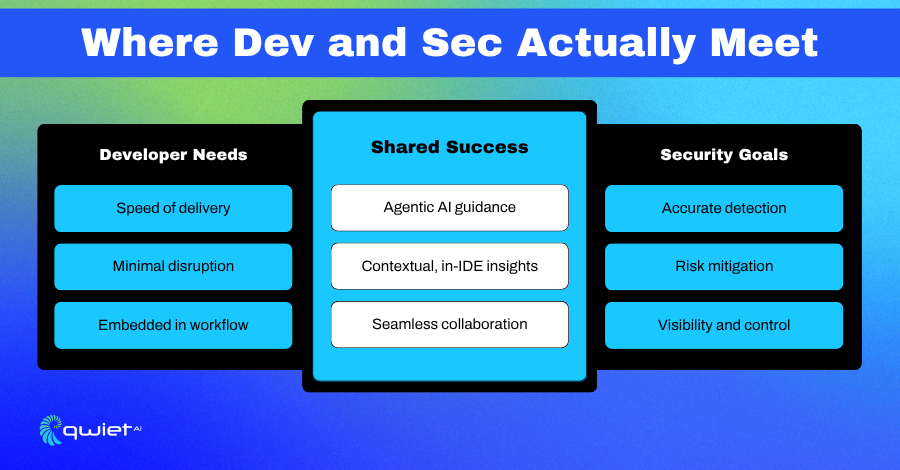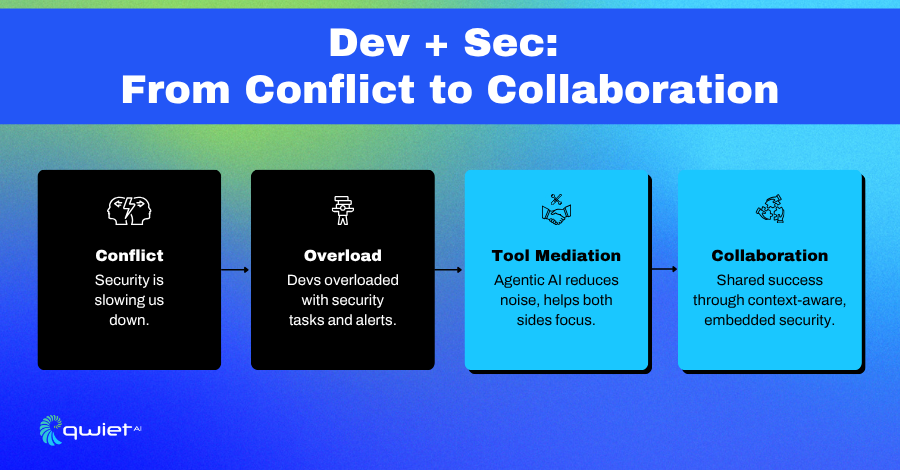Key Takeaways
- Shift left overburdened developers without giving them the right tools or support. The intention was solid, but the execution often left devs overwhelmed and security goals unmet.
- Shifting to the middle means shared responsibility, not shifted burden. With security integrated contextually into dev workflows, both speed and protection improve.
- Developer-security collaboration thrives when tools are embedded, relevant, and low-friction. Platforms that fit into daily work, not disrupt it, rebuild trust, and deliver better outcomes.
Introduction
“Shift left” started with a good goal: bring security closer to development. But somewhere along the way, it turned into dogma. Developers were expected to carry more security responsibilities without the right tools, support, or context. Meanwhile, some teams overcorrected, pushing security checks back to the end of the pipeline and breaking the original intent altogether. It’s time to reset. Moving forward means finding the middle ground where security and development work together, within the workflow, with the help of intelligent automation and a shared understanding.
The Overcorrection of Shift Left

Shifted Too Far Left? Now You’re Right Back Where You Started
Shift left began with good intentions: to catch issues earlier, save time, and improve quality. However, in practice, the situation was far less balanced. Many teams interpreted it as a mandate to push security responsibilities directly onto developers, without modifying the tools, workflows, or expectations to align with them.
Suddenly, devs were expected to act like security pros. They were handed tools built for security teams, asked to decipher alerts that lacked context, and told to fix issues they hadn’t introduced. There wasn’t much training.
There wasn’t much support. And the tools rarely helped make sense of the output. What followed was predictable. Alert fatigue kicked in. Triaging took longer than fixing. Security became a blocker instead of a partner. Trust between the development and security teams began to erode, and collaboration gave way to finger-pointing or avoidance.
When Shift Left Becomes a Swerve
The overcorrection meant that many organizations swung too far in the other direction. Security was re-centralized, pushed to later in the cycle, or offloaded to scanning gates at release time. They undermined the value of early detection altogether to make things less painful.
Now, many teams are stuck. Developers aren’t engaged with security meaningfully, and security teams lack the bandwidth to review every line. The result is a loop in which both sides feel overwhelmed and under-supported.
It’s not that shift left was wrong; it wasn’t implemented with balance. What’s missing isn’t effort; it’s context, support, and the proper placement of responsibility. That sets the stage for a better model that doesn’t pull too far in either direction.
The Case for the Middle Ground

The Middle Path: Where Dev and Sec Meet
Moving everything left didn’t work, pulling it all back right doesn’t either. The answer lies somewhere in between, where both development and security share the responsibility without dumping the workload on one side.
In the middle, developers aren’t asked to become security experts overnight. Instead, they receive help exactly where it makes sense, in line with their current work, and aligned with what they’re already doing. Security teams, in turn, gain visibility earlier without slowing things down or disrupting engineers’ workflow.
The middle model only works if the tools are available where the work is done. That means inside the IDE, inside PRs, and during build, not in separate dashboards that require jumping out of your workflow just to understand what’s happening.
Platforms That Fit the Flow
For the middle to function, tools have to adapt to developers’ work, not the other way around. That means fewer pop-ups, fewer false positives, and more guidance that aligns with the actual structure and intent of the code.
Qwiet is built to operate this way. Our platform surfaces relevant security insights during development, helps prioritize what matters, and provides direct, contextual guidance for fixing real issues, not just listing them. It doesn’t flood the pipeline with raw findings or slow teams down with extra steps.
This isn’t about reducing standards. It’s about removing the friction that has kept security and development at odds for years. When the middle works, everyone moves faster and more securely without trading off one for the other.
Reducing Friction, Restoring Flow

Helping Developers Without Handcuffing Them
Security tools haven’t always made life easier for developers. Many still generate excessive noise, flagging issues without sufficient context or relevance. The result is wasted time sorting through alerts, many of which never lead to actual action.
That kind of overload doesn’t improve outcomes; it adds another layer of work. Developers get stuck triaging instead of building, while security teams struggle to get buy-in on tools seen as blockers. It creates a loop that slows everyone down.
What’s needed is clarity, not volume. Less noise. More signal. And that starts with tools that know when to speak up and what to say.
Real Guidance, Not Guesswork
Qwiet integrates directly into the IDE, where the work is already happening. Instead of pushing developers into external portals or sending generic alerts, it delivers context-aware insights into the workflow. That means more relevant findings and fewer distractions.
The platform can automatically triage findings, link related issues, and flag the most important ones. It points developers to specific lines of code, explains the impact, and offers fixes they can apply with minimal friction. There are no extra tickets, and there is no back-and-forth just to figure out what needs attention.
This kind of support doesn’t take control away from developers; it gives them what they need to move faster with confidence. That’s how flow gets restored and security becomes part of the work, not separate.
Rebuilding the Developer-Security Relationship

From Enemies to Allies
There has been a long-standing tension between development and security teams. Security is often perceived as the team that slows things down, introduces blockers into the workflow, or adds steps with little visible return. That perception isn’t always fair, but it’s common and creates walls that are hard to break down.
When developers feel pressured to deliver quickly and security teams feel responsible for catching everything, friction is inevitable. Misaligned goals lead to shallow tool adoption, skipped checks, or rushed fixes, which hurt speed and safety.
The answer isn’t more mandates or more meetings, it’s better tooling that supports shared goals without forcing either side to compromise how they work.
Tools That Build Trust
Shifting to the middle opens space for empathy. When platforms respect developers’ thinking and provide the security insights they need without overwhelming the process, both sides can focus on what they do best.
Qwiet was built with that in mind. We designed it to educate while it surfaces not just problems but also reasons, explanations, and clear actions. That clarity builds trust. Developers aren’t left guessing why something matters, and security teams aren’t left in the dark about what’s being fixed.
This creates a better loop where developers learn from the tool, apply cleaner fixes faster, and stay in sync with security without stepping out of their zone. When both teams see outcomes improve without added complexity, the relationship shifts. That’s what turns tension into collaboration.
Conclusion
Shift left wasn’t a bad idea; it got pushed too far without enough balance. Real progress now means building in the middle where tools appear when and where developers need them, context drives decisions, and both speed and safety can coexist within the same process. Teams don’t have to pick between hitting deadlines and writing secure code when platforms support that middle ground. They get both, and it works. Curious how this looks inside your workflow? Book a demo. We’ll show you what middle-ground security feels like when it’s built to support, not slow you down.
FAQs
What does “shift to the middle” mean in software security?
It refers to placing security checks and context-aware tooling directly in the development workflow so developers can receive support without added friction.
Why did shift-left security strategies fail developers?
They pushed security responsibilities onto developers without providing meaningful support or tools that fit their existing workflows.
How can dev and security teams better collaborate?
Using tools that integrate security context directly into the IDE and CI/CD pipeline enables both teams to work with shared visibility and fewer handoffs.
What makes Qwiet’s approach to AppSec different?
Qwiet operates within development tools, prioritizing relevant issues and enabling quick, guided fixes, bridging the gap between security goals and developer workflows.
What’s the benefit of shifting security “to the middle”?
It balances speed and safety by allowing developers to work without unnecessary blockers while identifying and resolving security risks earlier in the lifecycle.
